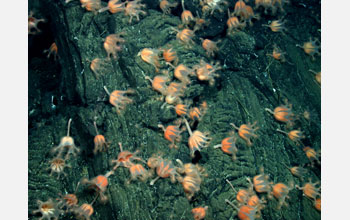Multimedia Gallery
New Undersea Vent (Image 4)
New Undersea Vent (Image 4)
A pink form of the jellyfish order Stauromedusae near the newly discovered Medusa hydrothermal vent field, as photographed by the remotely operated vehicle (ROV) Jason II.
The vent field was named the Medusa hydrothermal vent field to highlight the presence of these pink jellyfish, and also the numerous spiky tubeworm casings that festoon the vent chimney and bring to mind "the serpent-haired Medusa of Greek myth," said expedition leader Emily Klein, a geology professor from Duke University's Nicholas School of the Environment and Earth Sciences. It's likely that the pink bell-shaped jellyfish sighted near the vent may be previously undiscovered.
This image was taken during a research voyage on the Woods Hole Oceanographic Institution (WHOI) research vessel Atlantis. The research trip was supported by the National Science Foundation's (NSF) RIDGE 2000 Program (under grant OCE 05-26120). The purpose of the cruise was to explore the relationships between surface geology, geochemistry and hydrothermal activity, as well as the seismically determined distribution of melt in magma chambers beneath the 9°03N Overlapping Spreading Center along the East Pacific Rise. The multidisciplinary and multi-institutional program was led by principal investigators from Duke University, the Universities of South Carolina, Florida and New Hampshire, and WHOI.
The original ROV Jason was designed and built by WHOI's Deep Submergence Laboratory to allow scientists access to the seafloor without leaving the deck of a ship. Jason was first launched in 1988, and the system has been used for hundreds of dives to hydrothermal vents in the Pacific, Atlantic and Indian Oceans. It is now in its second generation, with a sturdier, more advanced vehicle--the Jason II, launched in 2002.
To learn more about the research cruise, see the Science Daily story "New Undersea Vent Suggests Snake-headed Mythology." (Date of Image: April 2007) [One of five related images. See Next Image.]
Credit: Emily M. Klein, Duke University
Images and other media in the National Science Foundation Multimedia Gallery are available for use in print and electronic material by NSF employees, members of the media, university staff, teachers and the general public. All media in the gallery are intended for personal, educational and nonprofit/non-commercial use only.
Images credited to the National Science Foundation, a federal agency, are in the public domain. The images were created by employees of the United States Government as part of their official duties or prepared by contractors as "works for hire" for NSF. You may freely use NSF-credited images and, at your discretion, credit NSF with a "Courtesy: National Science Foundation" notation.
Additional information about general usage can be found in Conditions.
Also Available:
Download the high-resolution JPG version of the image. (2.6 MB)
Use your mouse to right-click (Mac users may need to Ctrl-click) the link above and choose the option that will save the file or target to your computer.



